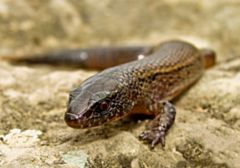Project 2601: S. J. Sanchez-Pacheco, O. Torres-Carvajal, V. Aguirre-Penafiel, P. M. Sales Nunes, L. Verrastro, G. A. Rivas, M. T. Rodrigues, T. Grant, R. W. Murphy. 2018. Phylogeny of Riama (Squamata: Gymnophthalmidae), impact of phenotypic evidence on molecular datasets, and the origin of the Sierra Nevada de Santa Marta endemic fauna. Cladistics. 34 (3):260-291.
Abstract
Riama is the most speciose genus of the Neotropical lizard family Gymnophthalmidae. Its more than 30 montane species occur throughout the northern Andes, the Cordillera de la Costa (CC) in Venezuela, and Trinidad. We present the most comprehensive phylogenetic analysis of Riama to date based on a total evidence (TE) approach and direct optimization of molecular and morphological evidence. Analyses use DNA sequences from four loci and 35 phenotypic characters. The dataset consists of 55 ingroup terminals representing 25 of the 30 currently recognized species of Riama plus five undescribed taxa, including an endemic species from the Sierra Nevada de Santa Marta (SNSM) in Colombia, and 66 outgroup terminals of 47 species. Analysis results in a well?supported hypothesis in which Riama is polyphyletic, with its species falling into three clades. The Tepuian Anadia mcdiarmidi nests within one clade of Riama, and the recently resurrected Pantodactylus nests within Cercosaura. Accordingly, we propose a monophyletic taxonomy that reflects historical relationships. Analysis of character evolution indicates that the presence/absence of prefrontals-a cornerstone of the early genus?level taxonomy of cercosaurines-is optimally explained as having been plesiomorphically present in the most recent common ancestor of Cercosaurinae and lost in that of the immediately less inclusive clade. Multiple independent reversals to present and subsequent returns to absent occur within this clade. To evaluate the impact of phenotypic evidence on our results, we compare our TE results with results obtained from analyses using only molecular data. Although phenotypic evidence comprises only 1.2% of the TE matrix, its inclusion alters both the topology and support values of the clades that do not differ. Finally, current phylogenetic evidence reveals a SNSM-CC-Trinidad-tepuis biogeographical link. We hypothesize that an ancient connection facilitated the exchange of species between the SNSM and the CC.Read the article »
Article DOI: 10.1111/cla.12203
Project DOI: 10.7934/P2601, http://dx.doi.org/10.7934/P2601
| This project contains |
|---|
Download Project SDD File |
Currently Viewing:
MorphoBank Project 2601
MorphoBank Project 2601
- Creation Date:
24 January 2017 - Publication Date:
21 November 2018
Authors' Institutions ![]()
- Universidade Federal do Rio Grande do Sul
- University of Toronto
- Royal Ontario Museum
- Universidade Federal de Pernambuco
- Pontificia Universidad Católica del Ecuador
- Universidad del Zulia
Members
| member name | taxa |
specimens |
media |
| Santiago J. Sanchez-Pacheco Project Administrator | 1 | 0 | 0 |
Project has no matrices defined.
Project downloads 
| type | number of downloads | Individual items downloaded (where applicable) |
| Total downloads from project | 163 | |
| Project downloads | 154 | |
| Document downloads | 9 | Characters and states (2 downloads); Morphology matrix (4 downloads); Molecular_(tree-alignment)_matrix (2 downloads); Total_evidence_(tree-alignment)_matrix (1 download); |

